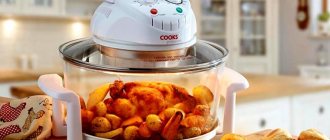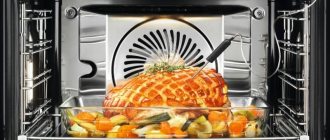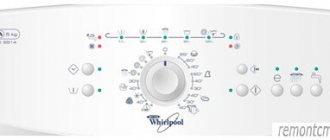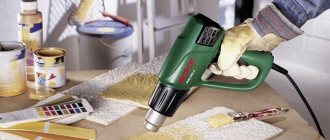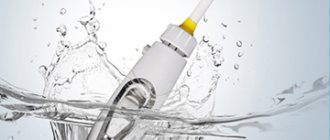Inhaler - what is it and how does an inhaler work? How to use an inhaler at home for cough, asthma, bronchitis.
Inhalation is considered the fastest and safest way to treat the respiratory system. With its help, medicinal substances fall directly onto the inflamed tissue, which significantly speeds up the therapy process. An indisputable advantage of inhalation is that medications do not need to be taken through the gastrointestinal tract. Overcoming this path, all kinds of tablets and syrups not only lose some of their beneficial properties until they reach the desired organs, but also cause certain harm, first of all, to organs such as the stomach, liver and kidneys, which pass all substances through themselves.
Inhalers are a worthy replacement for the dangerous procedure of inhalation over a saucepan.
Inhalation has been known to mankind since ancient times; even then, doctors suggested that patients breathe over herbal infusions. In the modern world, medicine has made great progress and now the medical equipment market offers a variety of inhalers for the treatment of various diseases. And clinic doctors are increasingly prescribing inhalation therapy to patients with respiratory diseases.
What is an inhaler for and what is an inhaler?
Before you begin the procedures, it is worth understanding what an inhaler is. This name originates in Latin; if translated literally, inhaler will mean inhale. So, an inhaler is a special device that directs medications into the body through the respiratory tract.
Schematic design of a nebulizer.
A nebulizer is a popular type of inhaler; its name also comes from the Latin language and translates as fog or cloud. A nebulizer operates on the same principle; a medicinal solution is converted into an aerosol using a special mechanism, which the patient needs to inhale.
These two devices have virtually no differences, so their names are basically synonymous.
However, experts insist on the fundamental difference between an inhaler and a nebulizer. The fact is that the latter has a narrower specificity of application and acts most accurately on the affected areas of the respiratory system. The quality of treatment depends on the size of the particles into which the substance is sprayed; the smaller they are, the more effective the treatment will be. Therefore, steam-based inhalers cannot be called a nebulizer; the rest can be called any variation.
Steam inhaler vs humidifier
Be it humidifiers, vaporizers, aromatherapy diffusers or steam inhalers, they all perform a similar function, which is to introduce moisture into the atmosphere. However, the mechanism and purpose of each product are different from each other. Humidifiers and steam inhalers serve the same purpose (to increase humidity), but they are slightly different.
Humidifiers do not include a heating element and increase the level of humidity in the air without raising the temperature. Steam inhalers are a type of vaporizer that increase both the humidity and temperature of the air. Steam inhalers can release moisture directly into the user's sinuses and lungs, while humidifiers break water into tiny particles that can be inhaled. Steam inhalers are effective in producing short-term results, unlike humidifiers.
Let's now take a look at the 10 best electric steam inhalation machines that you can buy.
Why do you need an inhaler?
Treatment with an inhaler has long been proven effective. Not surprisingly, inhalations help eliminate colds, coughs and runny noses, moisturize the mucous membrane of the respiratory tract, which alleviates the patient’s condition and removes phlegm. In addition, inhalations prevent or reduce symptoms of diseases such as bronchitis and asthma.
The process of formation of a therapeutic aerosol.
The inhalation process allows the medicinal solution to enter the tissues of the most distant respiratory organs, which in turn contributes to the treatment of chronic diseases, influenza and acute respiratory viral infections.
The nebulizer is suitable for treating the symptoms of colds and acute respiratory viral infections.
An inhaler at home becomes especially indispensable when there are small children. In case of colds, the device will be a real salvation, which will allow you to quickly cure your baby without side effects. Another advantage of having an inhaler for home use is that you can carry out treatment procedures without leaving your apartment, which is important for mothers of small children, because during illness it is better not to bring them to the hospital, there is a high risk of complications due to weakened immunity. The healing solution is quickly absorbed, which allows you to recover faster.
What types of nebulizers are there?
Nebulizers also come in several types, but they all form very small particles of the active substance. This determines the peculiarities of using the device. Thus, a steam inhaler is not suitable for treating asthma or bronchitis, since large particles from the steam do not reach the affected organs, settling in the upper part of the respiratory system. Accordingly, nebulizers are suitable for the treatment and prevention of a wider range of diseases.
Devices are:
- Compressor - they are also called jet. This device has an electromechanical supercharger-compressor and a nebulizer chamber, inside of which an aerosol is formed. This process occurs due to the influence of a powerful air jet, which is formed by a compressor and breaks down the medicinal composition. A wide variety of medications can be used in this type of nebulizer; its advantage is minimal loss of solution. The only downside is the relatively noisy operation of the device (45-55 dB);
- Ultrasonic - the design includes a piezoelectric element that creates ultrasonic vibrations. This ensures that the drug is broken down and converted into an aerosolized substance. Devices of this type have several disadvantages. Firstly, they are not suitable for the use of a number of drugs that lose their properties under the influence of ultrasound. Secondly, when spraying, particles are created of a size that interferes with the effective effect in the treatment of COPD and bronchial asthma;
- Membrane is another name for mesh inhaler. They also use ultrasound, but it does not act on the drug, but on a mesh-shaped membrane. Vibrations of this membrane contribute to the dispersion of the substance passing through it. The main disadvantage of the device is related to its design: the membrane has to be cleaned regularly. In addition, membrane nebulizers are the most expensive.
There are many indications for using a nebulizer; the list includes almost all pathologies of the respiratory system. This applies to tracheitis and bronchitis, fungal infections of the respiratory system and cystic fibrosis, tuberculosis and bronchial asthma. The devices are effective at various stages of ENT pathologies in the form of sinusitis, rhinitis, laryngitis, for the prevention and treatment of COPD, and for postoperative complications.
For what diseases is the inhaler used?
Inhalation procedures can be performed on a person of any age. This universal device can fight not only colds, but also asthma and bronchial diseases. Using a home inhaler makes the procedure more comfortable and safe.
The principle of operation of the inhaler is to continuously supply steam with the medicine dissolved in it, the patient can only breathe it. So, inhalers are designed to fight diseases of the body’s respiratory system, and they can also be used for preventive purposes. What diseases can a modern nebulizer cope with? The list of ailments is divided into several groups, each with its own characteristics:
- First group. Complex diseases accompanied by acute attacks requiring emergency care. This happens with asthma and allergic manifestations. For these diseases, an inhaler is the main way to relieve symptoms. The medicinal composition for the procedures is prescribed by an allergist.
- Second. Chronic diseases such as bronchitis or rhinitis. Such diseases begin to develop from a very young age. Therefore, if a child often suffers from colds, an inhaler in the house will be an indispensable means of strengthening the baby’s health. Inhalation when coughing will only speed up the healing process in both adults and children. This happens because the drug reaches the inflamed areas directly.
For bronchitis, inhalation therapy is often prescribed. - Third. These are inflammatory processes of the respiratory tract, for example, pharyngitis, laryngitis and rhinitis.
- Fourth. These are diseases acquired as a result of working in hazardous industries. For example, miners or chemical industry workers.
- Fifth. Patients with disorders of the immune, nervous, and vascular systems.
It is worth examining in more detail the question of for which cough inhaler therapy is recommended. Basically, inhalation is prescribed to alleviate dry cough, which makes itself felt during a cold. Associated symptoms are usually dryness and inflammation of the throat tissue. The inhaler helps relieve swelling in the throat and also moisturize the tissues of the respiratory tract.
The inhaler will also cope with cough and sore throat.
Cough with phlegm can also be treated with an inhaler. Here the procedure is aimed at liquefying and removing viscous secretions from the lungs. Depending on the type of cough, the doctor prescribes the drug.
What is a nebulizer for?
Kartashova N.K.
Patient's Guide. You can learn about what a nebulizer is, what diseases can be treated with its help, how to carry out inhalation correctly, how to choose a nebulizer, and much more about the modern method of inhalation therapy from this article.
NEBULIZER THERAPY IS MODERN AND SAFE
In the treatment of respiratory diseases, the most effective and modern method is inhalation therapy. Inhalation of medications through a nebulizer is one of the most reliable and simplest treatment methods. The use of nebulizers in the treatment of respiratory diseases is gaining increasing recognition among doctors and patients.
To make the medicine easier to penetrate into the respiratory tract, it should be converted into an aerosol. A nebulizer is a chamber in which a medicinal solution is sprayed into an aerosol and delivered into the patient’s respiratory tract. The healing aerosol is created due to certain forces. Such forces can be air flow (compressor nebulizers) or ultrasonic vibrations of the membrane (ultrasonic nebulizers).
The modern approach to the treatment of respiratory diseases involves delivering drugs directly to the respiratory tract through the widespread use of inhaled forms of drugs. The capabilities of the nebulizer have dramatically expanded the scope of inhalation therapy. Now it has become available to patients of all ages (from infancy to old age). It can be performed during periods of exacerbation of chronic diseases (primarily bronchial asthma), in situations where the patient has a significantly reduced inhalation rate (young children, postoperative patients, patients with severe somatic diseases) both at home and in a hospital setting.
Nebulizer therapy has advantages over other types of inhalation therapy:
- It can be used at any age, since the patient is not required to adjust his breathing to the operation of the device and at the same time perform any actions, for example, pressing the canister, holding the inhaler, etc., which is especially important in young children.
- The absence of the need to take a strong breath allows the use of nebulizer therapy in cases of severe attacks of bronchial asthma, as well as in elderly patients.
- Nebulizer therapy allows the use of drugs in effective doses without side effects.
- This therapy provides a continuous and rapid supply of medication using a compressor.
- It is the safest method of inhalation therapy, since it does not use, unlike metered-dose aerosol inhalers, propellants (solvents or carrier gases).
- This is a modern and comfortable method of treating bronchopulmonary diseases in children and adults.
WHAT DISEASES CAN BE TREATED WITH A NEBULIZER?
The drug sprayed by an inhaler begins to act almost immediately, which makes it possible to use nebulizers, first of all, for the treatment of diseases that require immediate intervention - asthma, allergies.
Another group of diseases for which inhalations are simply necessary are chronic inflammatory processes of the respiratory tract, such as chronic rhinitis, chronic bronchitis, bronchial asthma, chronic broncho-obstructive pulmonary disease, cystic fibrosis, etc.
But their scope of application is not limited to this. They are good for the treatment of acute respiratory diseases, laryngitis, rhinitis, pharyngitis, fungal infections of the upper respiratory tract, and the immune system.
Inhalers help with occupational diseases of singers, teachers, miners, and chemists.
IN WHAT CASES IS A NEBULIZER NEEDED AT HOME:
- In a family where there is a child who is susceptible to frequent colds, bronchitis (including those occurring with broncho-obstructive syndrome), for the complex treatment of cough with difficult to separate sputum, treatment of stenosis.
- Families with patients with chronic or often recurrent bronchopulmonary diseases (bronchial asthma, chronic obstructive pulmonary disease, chronic bronchitis, cystic fibrosis).
WHAT MEDICINES CAN BE USED IN A NEBULIZER
For nebulizer therapy, there are special solutions of drugs that are produced in bottles or plastic containers - nebulas. The volume of the medicine together with the solvent for one inhalation is 2-5 ml. Calculation of the required amount of medication depends on the age of the patient. First, 2 ml of saline solution is poured into the nebulizer, then the required number of drops of medicine is added. Distilled water should not be used as a solvent, as it can provoke bronchospasm, which will lead to coughing and difficulty breathing during the procedure. Pharmacy packaging with medications is stored in the refrigerator (unless otherwise indicated) closed. After the pharmaceutical package has been opened, the drug must be used within two weeks. It is advisable to write down the date on which you started using the drug on the bottle. Before use, the medicine must be warmed to room temperature.
For nebulizer therapy the following can be used:
- mucolytics and mucoregulators (drugs for thinning sputum and improving expectoration): Ambrohexal, Lazolvan, Ambrobene, Fluimucil;
- bronchodilators (drugs that dilate the bronchi): Berodual, Ventolin, Berotek, Salamol;
- glucocorticoids (hormonal drugs with multilateral effects, primarily anti-inflammatory and anti-edematous): Pulmicort (suspension for nebulizers);
- cromones (antiallergic drugs, mast cell membrane stabilizers): Cromohexal Nebula;
- antibiotics: Fluimucil antibiotic;
- alkaline and saline solutions: 0.9% saline solution, Borjomi mineral water
Your attending physician should prescribe the drug and tell you about the rules for its use. He must also monitor the effectiveness of treatment.
NOT RECOMMENDED FOR USE FOR NEBULIZERS:
ALL SOLUTIONS CONTAINING OILS, SUSPENSIONS AND SOLUTIONS CONTAINING SUSPENDED PARTICLES, INCLUDING DESUCTIONS AND INDUCTIONS OF HERBS, AS WELL AS SOLUTIONS OF EUPHYLLINE, PAPAVERINE, PLATIFYLLINE, DIMEDROL AND SIMILAR DRUGS, AS WITHOUT T POINTS OF APPLICATION ON THE MUCOSA OF THE RESPIRATORY TRACT.
WHAT SIDE EFFECTS ARE POSSIBLE WHEN CARRYING OUT NEBULISER THERAPY?
When breathing deeply, symptoms of hyperventilation (dizziness, nausea, cough) may appear. It is necessary to stop inhalation, breathe through your nose and calm down. After the symptoms of hyperventilation disappear, inhalation through a nebulizer can be continued.
During inhalation, as a reaction to the administration of the sprayed solution, coughing may occur. In this case, it is also recommended to stop inhalation for a few minutes.
INHALATION METHOD USING A NEBULIZER
- Before handling the inhaler, you should (always) wash your hands thoroughly with soap and water, as... there may be pathogenic microbes on the skin.
- Assemble all parts of the nebulizer according to the instructions
- Pour the required amount of the drug into the nebulizer cup, preheating it to room temperature.
- Close the nebulizer and attach the face mask, mouthpiece or nasal cannula.
- Connect the nebulizer and compressor using a hose.
- Turn on the compressor and inhale for 7-10 minutes or until the solution is completely consumed.
- Turn off the compressor, disconnect the nebulizer and disassemble it.
- Wash all parts of the nebulizer with hot water or 15% baking soda solution. Brushes and squeegees should not be used.
- Sterilize the disassembled nebulizer in a steam sterilization device, such as a thermal disinfector (steam sterilizer) designed for treating baby bottles. Sterilization by boiling for at least 10 minutes is also possible. Disinfection must be carried out once a week.
- The thoroughly cleaned and dried nebulizer should be stored in a clean napkin or towel.
BASIC RULES FOR INHALATION
- Inhalations are carried out no earlier than 1-1.5 hours after eating or significant physical activity.
- During the course of inhalation treatment, doctors prohibit smoking. In exceptional cases, before and after inhalation, it is recommended to stop smoking for an hour.
- Inhalations should be taken in a calm state, without being distracted by reading or talking.
- Clothing should not restrict the neck or make breathing difficult.
- For diseases of the nasal tract, inhalation and exhalation must be done through the nose (nasal inhalation), breathing calmly, without tension.
- For diseases of the larynx, trachea, bronchi, and lungs, it is recommended to inhale the aerosol through the mouth (oral inhalation), breathing deeply and evenly. After taking a deep breath through your mouth, you should hold your breath for 2 seconds, and then exhale completely through your nose; in this case, the aerosol from the oral cavity enters further into the pharynx, larynx and further into the deeper parts of the respiratory tract.
- Frequent deep breathing can cause dizziness, so periodically it is necessary to interrupt inhalation for a short time.
- Before the procedure, you do not need to take expectorants or rinse your mouth with antiseptic solutions (potassium permanganate, hydrogen peroxide, boric acid).
- After any inhalation, and especially after inhalation of a hormonal drug, it is necessary to rinse your mouth with boiled water at room temperature (a small child can be given drink and food); if using a mask, rinse your eyes and face with water.
- The duration of one inhalation should not exceed 7-10 minutes. The course of treatment with aerosol inhalations is from 6-8 to 15 procedures.
WHAT ARE THE TYPES OF NEBULIZERS?
Currently, three main types of inhalers are used in medical practice: steam, ultrasonic and compressor.
The action of steam inhalers is based on the effect of evaporation of the medicinal substance. It is clear that only volatile solutions (essential oils) can be used in them. The biggest disadvantage of steam inhalers is the low concentration of the inhaled substance, usually less than the threshold for therapeutic effects, as well as the inability to accurately dose the drug at home.
Ultrasonic and compressor are combined by the term “nebulizers” (from the Latin word “nebula” - fog, cloud); they generate not vapor, but an aerosol cloud consisting of microparticles of the inhaled solution. A nebulizer allows you to administer pure medications to all respiratory organs (nose, bronchi, lungs), without any impurities. The dispersion of aerosols produced by most nebulizers ranges from 0.5 to 10 microns. Particles with a diameter of 8-10 microns settle in the oral cavity and trachea, with a diameter from 5 to 8 microns - in the trachea and upper respiratory tract, from 3 to 5 microns - in the lower respiratory tract, from 1 to 3 microns - in bronchioles, from 0. 5 to 2 microns – in the alveoli. Particles smaller than 5 microns are called the “respirable fraction” and have the maximum therapeutic effect.
Ultrasonic nebulizers spray the solution with high-frequency (ultrasonic) vibrations of the membrane. They are compact, silent, and do not require replacement of nebulization chambers. The percentage of aerosol that reaches the mucous membrane of the respiratory tract exceeds 90%, and the average size of aerosol particles is 4-5 microns. Thanks to this, the required drug in the form of an aerosol in high concentration reaches the small bronchi and bronchioles.
The choice of ultrasonic nebulizers is more preferable in cases where the area of action of the drug is small bronchi, and the drug is in the form of a saline solution. However, a number of drugs, such as antibiotics, hormonal drugs, mucolytics (thinning sputum), can be destroyed under the influence of ultrasound. These drugs are not recommended for use in ultrasonic nebulizers.
Compressor nebulizers form an aerosol cloud by forcing a powerful air stream pumped by a compressor through a narrow opening in a chamber containing a medicinal solution. The principle of using compressed air in compressor nebulizers is the “gold standard” of inhalation therapy. The main advantage of compressor nebulizers is their versatility and relative cheapness, they are more accessible and can spray almost any solution intended for inhalation.
Compressor nebulizers have several types of chambers:
· convection chambers with constant aerosol output;
Breath-activated cameras
Breath-activated chambers with flow interrupter valve.
When inhaling medicinal substances through a nebulizer, it is necessary to take into account some features:
· the optimal filling volume of the nebulizer chamber is at least 5 ml;
· to reduce the loss of the drug at the end of inhalation, you can add 1 ml of physiological solution to the chamber, after which, shaking the nebulizer chamber, continue inhalation;
· when using inexpensive and accessible drugs, all types of nebulizers can be used, but when using more expensive drugs, the greatest effectiveness of inhalation therapy is provided by nebulizers activated by the patient's inhalation and equipped with a valve flow interrupter during the exhalation phase. These devices are especially effective in the treatment of bronchopulmonary diseases.
HOW TO CHOOSE A NEBULIZER?
When treated with a nebulizer, the medicine is delivered to the respiratory tract. This particular treatment is intended for those who have a disease affecting the respiratory tract (rhinitis, laryngitis, tracheitis, bronchitis, bronchial asthma, chronic obstructive pulmonary disease, etc.). In addition, sometimes the mucous membrane of the respiratory tract is used to introduce drugs into the human body. The surface of the bronchial tree is very large, and many drugs, such as insulin, are actively absorbed through it.
The choice of inhaler depends on the disease you are going to treat and your financial capabilities.
In Russia, nebulizer manufacturers from Germany, Japan, and Italy represent their products on the medical equipment market. Unfortunately, there are no domestic manufacturers of compressor nebulizers yet. Detailed information about the technical characteristics of certain types of nebulizers can be obtained from Russian companies that sell them. When choosing a nebulizer, the requirements for the nebulizer and compressor are taken into account. For a compressor, the important factors are size, weight, operating noise, and ease of use. In all these parameters they differ slightly. But it should be noted that nebulizers from PARI GmbH (Germany) are distinguished by traditionally high German quality, exceptional efficiency and long service life. They ensure maximum deposition of medications in the respiratory tract due to optimal aerosol dispersion.
Perhaps the main attention should be paid to the type of sprayer. Nebulizers equipped with a direct-flow nebulizer make sense to use in young children, since they do not have enough inspiratory force to activate the valves (and thus save medicine). For inhalation, children under 3 years of age should use a children's mask. Adults can also use this type of sprayer, because... It is initially equipped with a mouthpiece.
Breath-activated nebulizers have inhalation and exhalation valves that are activated alternately throughout the act of breathing. When using them, less aerosol is formed on exhalation, resulting in significant savings in medication.
There are also nebulizers that have a nebulizer equipped with a tee tube (aerosol flow interrupter), which allows you to regulate the formation of aerosol only during inhalation by blocking the side opening of the tee.
Various types of attachments are used with the nebulizer: mouthpieces, nasal cannulas (tubes), masks in adult and child sizes.
- Mouthpieces (adults and children) are optimal for delivering medications deep into the lungs; they are used for inhalation by adult patients, as well as children over 5 years old.
- Masks are convenient for treating the upper respiratory tract and allow you to irrigate all parts of the nasal cavity, pharynx, as well as the larynx and trachea. When using a mask, most of the aerosols settle in the upper respiratory tract. Masks are needed when using nebulizer therapy in children under 3 years of age, since it is impossible to carry out inhalations in such patients through a mouthpiece - children breathe mainly through the nose (this is due to the anatomy of the child’s body). It is necessary to use a mask of the appropriate size. Using a tight-fitting mask reduces aerosol loss in young children. If the child is over 5 years old, it is better to use a mouthpiece rather than a mask.
- Nasal cannulas (tubes) are needed to deliver a medicinal aerosol into the nasal cavity. They can be used in the complex treatment of acute and chronic rhinitis and rhinosinusitis.
MATERIAL FOR THE ARTICLE PROVIDED BY TRADE AND INFORMATION CENTER ALLERGOD
How to use the inhaler
Before starting the procedure, you need to study the rules for using the inhaler. First you need to disinfect your hands to prevent harmful bacteria from getting into the medicine. Next, the inhaler is assembled as indicated in the instructions. Next, a solution is poured into a special container: first the saline solution is poured, and then the medicine. You need to pour the substance using a new syringe. After preparation is completed, you can put on the mask and turn on the device. It is important to remember that the products used must be fresh, so before use you should pay attention to the expiration date.
The figure shows what size particles enter which area of the respiratory system.
The procedure lasts until the solution is completely dissolved, usually this takes about ten minutes. After the procedure is completed, you need to rinse the inhaler parts under a hot tap. There is no need to wash the parts with any sponges or brushes, just a little dishwashing detergent is enough. After thorough washing, the parts are dried and stored in a dry place out of reach of children.
Rules for inhalation
After the first sessions, visible results will appear. But not everyone knows how to properly carry out therapy and use an inhaler. And this is necessary for more effective and faster treatment. Below are the rules to follow:
- The session should begin no earlier than a couple of hours after eating and physical work.
- It is not recommended to talk.
- The patient should be dressed in clothing that does not restrict the neck and does not restrict the breathing process.
- If possible, you should avoid smoking throughout therapy, or at least not smoke for an hour after.
- If therapy is carried out to treat a runny nose, you need to inhale the aerosol through your nose.
- For bronchitis, tracheitis, sore throat and other inflammatory processes of the lower respiratory tract, you need to inhale through your mouth. You need to breathe evenly and calmly.
- Do not drink expectorants or use oral products.
- At the end of inhalation, rinse your nose and mouth with cool water. In case of inhalation using a mask, also wash your face.
- You can eat half an hour after the procedure.
- Inhalation sessions with treatment solutions can be used no more than three times a day.
Smoking negatively affects the effect of inhaler treatment.
How to choose the best steam inhaler?
Functionality
Different steam inhalers are designed to serve different purposes. So, your choice of steam inhaler should depend on the need, i.e. whether you need a steamer for facial cleansing or for clearing your respiratory tract.
Steam generation
Some inhalers have an automated vapor generation system, while some inhalers have adjustable vapor volume and flow. So, you need to choose an inhaler according to its purpose.
Ease of use
Steam inhalers should be easy to operate or use. There are different types of vapor inhalation devices. They can be battery operated or powered; they may have timer settings or some position to adjust the steam intensity. Whatever these features, steam inhalers should be selected based on ease of use.
Size
The size of a steam inhaler is entirely dependent on your ability to store, carry and maintain it. If you travel frequently, you may need a device that is compact and easy to carry.
Price
Your choice of purchasing a steam inhaler completely depends on your budget. A basic steam inhaler can cost around $30, but high-quality inhalers can cost around $200 or more.
Material
The material from which the steam inhaler is made determines its durability. Most of the devices available in the market are made of plastic. Aluminum and stationary steam inhalers are much safer and more durable.
Aromatherapy
Some essential oils work wonders in opening up the airways. You need to choose a steam inhaler that has two chambers - one for storing water and the other for storing essential oils.
Safety
Since using a steam inhaler involves handling hot water and steam, you will need to either be extremely careful when handling it or choose an inhaler that comes with a temperature control feature.
What medications to use
Depending on what needs to be treated, the following solutions are recommended:
- To eliminate a runny nose, it is enough to inhale with mineral water. This gentle method is great for babies and pregnant women. For more acute manifestations of a runny nose, you can use a solution containing Furacilin.
A safe component that can be used by children and pregnant expectant mothers. - Inhalation with saline solution or mineral water will help cope with cough. If we talk about more serious drugs, doctors prescribe Lazolvan, Ambrohexal and other drugs of the mucolytic group.
Medicines from the group of antibiotics should not be taken without a doctor’s recommendation, otherwise you can only harm your health.
Contraindications for inhalation
Before resorting to inhalation procedures, you should pay attention to contraindications. Inhalation cannot be performed if the patient has the following diseases:
- Frequent nosebleeds and diseases associated with bleeding in the lungs.
- Diseases of the nasopharynx with purulent discharge.
- Disorders of the cardiovascular system.
- Pathologies associated with the respiratory system.
In any case, each patient has his own characteristics of the body. Therefore, before using the inhaler, it is necessary to consult a doctor who will prescribe the correct treatment.
